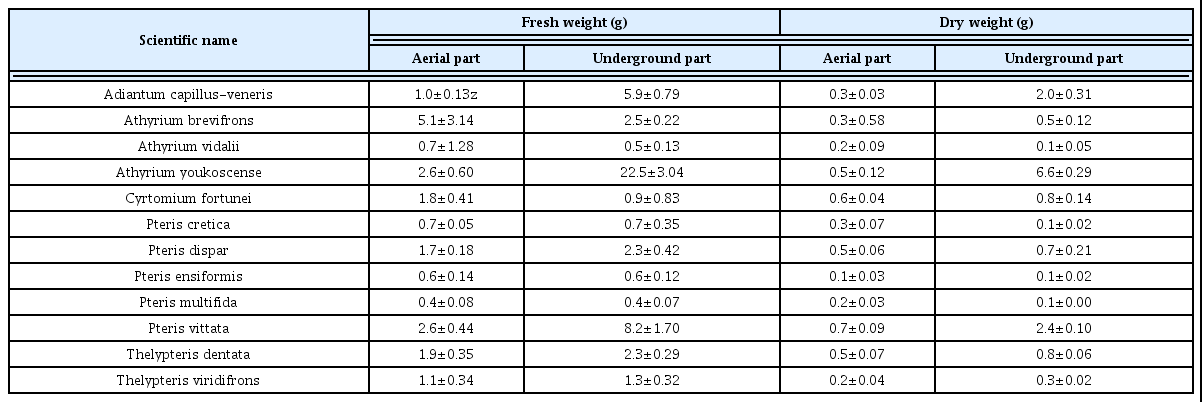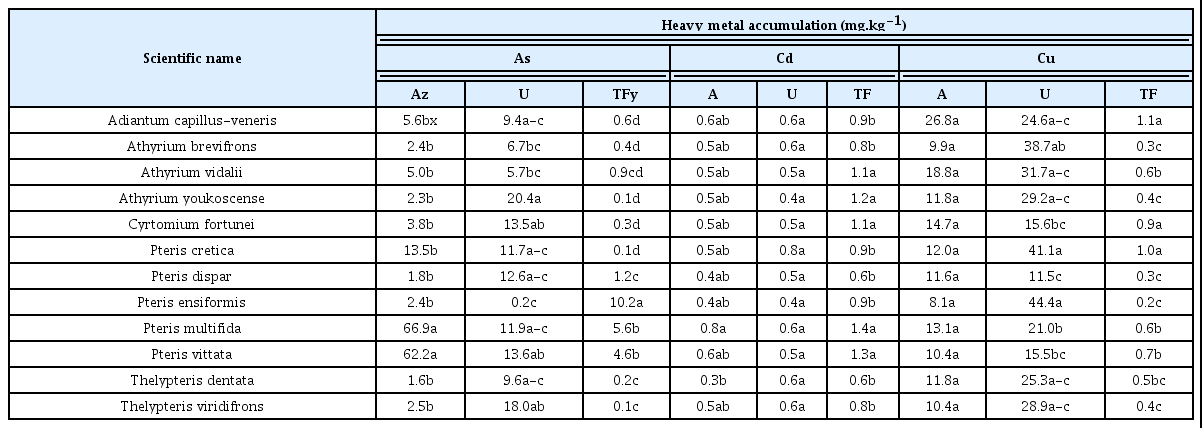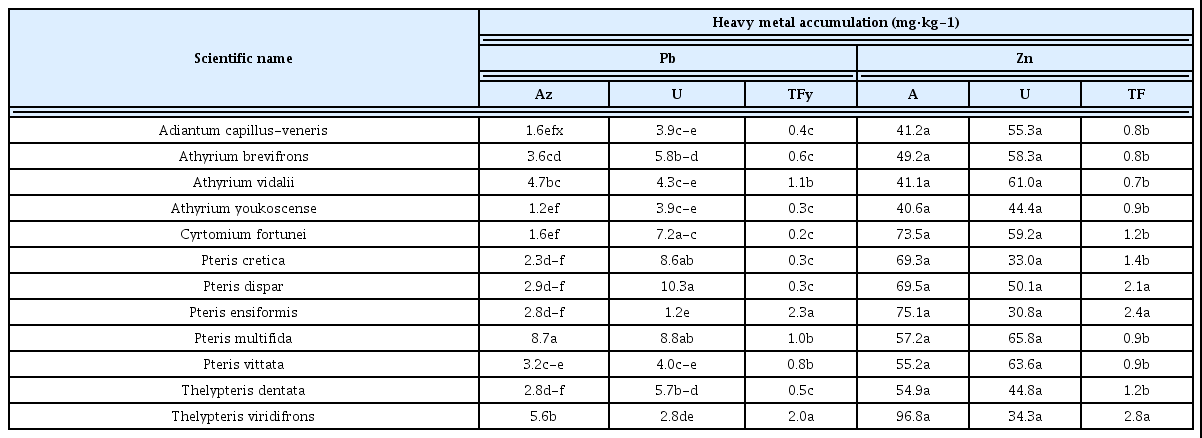중금속 오염 토양에서 양치식물 12종의 중금속 축적능 탐색
Screening for Heavy Metals Accumulation Ability of Twelve Pteridophyta Species at Soil Contaminated with Heavy Metals
Article information
Abstract
This study was performed to select the effective plant for phytoremediation of heavy metal contaminated areas. After cultivation of twelve Pteridophyta species on soil contaminated with heavy metals for 8 weeks, the growth response and accumulation ability of each parts for heavy metal, such as arsenic(As), cadmium(Cd), copper(Cu), lead(Pb), and zinc(Zn) were analyzed. Except Adiantum capillus-veneris, growth of eleven Pteridophyta species were relatively fine. Arsenic accumulation ability was the highest by Pteris multifida(66.9 mg․kg-1 DW) and P. vitata(62.2 mg․kg-1 DW) in aerial part, and P. vitata(13.6 mg․kg-1 DW) in underground part. On the other hand, cadmium accumulation ability was low in all the twelve species of Pteridophyta. The underground part of P. ensiformis showed the highest copper accumulation(44.4 mg․kg-1 DW) and in case of aerial part, Adiantum capillus-veneris(26.8 mg․kg-1 DW) was highest in copper content. In lead, 1.2(Athyrium yokoscens) ~ 8.8 mg․kg-1 DW(Pteris multifida) were accumulated in aerial part among twelve Pteridophyta species and 1.2(Pteris ensiformis) ~ 10.3 mg․kg-1 DW(P. dispar) in the underground part. The aerial part of Thelypteris viridifrons showed the highest zinc accumulation(96.8 mg․kg-1 DW) and in case of underground part, Pteris multifida(63.6 mg․kg-1 DW) showed the highest ability.
I. 서론
세계적으로 산업화와 인구의 도시 집중에 따른 토양 오염은 생 태계의 불균형(Wild, 1993) 및 농산물의 오염을 초래하여 농업 생 태계로부터 나오는 농산물을 섭취하는 인간의 건강을 위협하고 있 다(Allaway, 1968). 중금속에 의한 오염은 대기, 수질, 토양, 폐기 물 등 환경 전반에 걸쳐 나타날 수 있기 때문에 중금속 오염의 위험 성은 크게 인식되고 있으며, 그 특성상 일반 환경문제와는 달리 취 급되고 있다(Gang, 2002).
우리나라에는 공단, 주거지역, 교통 관련시설 및 어린이 놀이터 에 이르기까지 많은 지역이 중금속 오염에 대한 우려지역에 포함되 어 있다. 또한 국내의 폐기물 매립지, 유류 저장시설, 폐광지역, 제 철소 인근 등 대규모 오염 발생지역 주변의 환경오염은 심각한 사 회문제가 되고 있다. 국내에는 약 900여개의 금속광산, 380여개의 석탄광산, 1,200여개의 비금속광산을 포함하여 총 2,500개소의 크고 작은 광산이 있다. 이들 중에서 약 80%가 휴광 또는 폐광된 광 산인 것으로 조사되었다. 이러한 휴․폐광산 지역에 대한 토양오염 유발 방제 및 복원을 위한 시설이 전무하여 주변 생태계가 위협받 고 있다(Lee, 2008). 토양의 오염원 중 중금속 성분은 유기물이나 무기염류와는 달리 분해가 어렵고, 토양 중의 각종 유기물과 결합 하거나 중금속 간 또는 무기물과의 상호작용에 의해 토양에 축적되 고 장기간 잔류함으로써 식물에 전이되어 생육을 저해한다. 또한 먹이사슬을 통하여 이들 식물을 섭취하는 동물이나 인간에게 이행 되어, 각종 질병을 야기하는 등 심각한 위협이 되고 있다(Jeong, 2007).
이에 정부는 1994년에 토양환경보존법을 제정하여 중금속 오염 물질 관리를 시작하였다(Chung and Lee, 1997; Yun et al., 2010). 오염된 토양을 정화하기 위해 사용되는 물리·화학적 정화 기술은 비용이 많이 들고, 환경 파괴적인 요소를 가지고 있다. 이에 반해 친 환경적인 접근 방법인 생물학적 정화를 극대화한 기술, 즉 식물을 이용한 식물상 정화기법(phytoremediation)은 저탄소 녹색성장 과 함께 주목받고 있는 실정이다(Salt et al., 1995; Kim, 2009).
식물상 정화기법은 물리화학적 방법에 비해 경제적일 뿐만 아니 라 토양 안정화, 오염물질 이동의 최소화 등의 장점이 있어, 이 기법 에 적용 가능한 식물소재의 개발을 위한 연구가 활발히 시도되고 있다(Kim and Lee, 1999; Kim et al., 1999; Krishnaraj et al., 2000). 그러나 식물은 종별로 중금속에 대한 내성에 차이가 있으며 (Kang et al., 1996), 중금속 축적능은 토양의 pH, 토성 등의 물리· 화학적 특성(von Endt et al., 1968)과 토양 이온의 영향을 많이 받 으므로 현장 적용에 많은 어려움을 겪고 있다(Fitz and Wenzel, 2002). 이에 현장 적용실험을 통한 식물종의 생육 및 중금속 축적 능 탐색과 선발이 매우 필요한 실정이다.
양치식물인 Pteris vitata는 대표적인 비소 고축적 식물로 알려 져 있으며(Ma et al., 2001), 같은 Pteris 속의 식물에서도 비소 축 적능이 확인되어 양치식물에 대한 식물상 정화기법 적용 연구가 활 발히 이루어지고 있다(Du et al., 2005; Oh, 2006; Wang et al., 2006, 2007, 2011; Wei et al., 2007; Jeong, 2011; Ju, 2011). 그 러나 국내 자생 양치식물에 대한 연구는 전무한 실정이다.
따라서, 본 연구는 중금속 축적능이 높고, 관상가치가 우수한 종 으로 판단되는 양치식물 12종을 선발하여, 중금속 오염이 심각한 곳으로 알려진 제련소 주변지역에서 현장 적용을 통해 식물상 정화 기법에 적용 가능한 식물소재를 선발하고자 수행되었다.
II. 연구 방법
1. 실험 재료
실험에 이용된 식물종은 문헌조사(Lee, 1999)를 토대로 환경 적 응성이 높고, 생육이 우수하여 중금속 축적에 유리할 것으로 판단 되는 양치식물 12종을 선택하였다. 선발한 식물의 내한성과 내서 성 등의 환경적 특성을 고려하여 겨울철 기온이 낮고, 여름철 무더 운 연구지의 기후에 적합할 것으로 판단되는 식물을 선발하였다. 실험 재료는 무가온 비닐하우스에서 1년 동안 육묘한 동일한 생육 단계의 균일한 묘를 사용하였다(Table 1).
2. 연구 방법
2009년에 환경관리공단과 한국광해관리공단에서 실시한 토양 정밀조사 보고서를 참조하여 시험 부지를 선정하였다. 식물상 정화 기법의 소재를 선발하기 위하여, 제련소 주변에서 가장 많이 이용 하는 논토양에서 연구를 수행하였다(Fig. 1). 시험 부지의 중금속 오염농도를 분석한 결과, 비소가 45.794mg‧kg-1 DW 수준으로 토 양환경보전법 1지역의 토양오염 우려수준 25mg‧kg-1 DW를 초과 하여 토양정화가 시급한 지역이었다(Table 2).
시험 부지는 경운한 다음 물빠짐을 원활하게 하기 위하여 배수 로를 두었으며, 1.4×1.4m 규모로 시험구를 설치하였다. 잡초 방지 를 위해 시험구를 제외한 부분은 부직포(위드스탑)를 깔아 멀칭하 였다. 식물은 2009년 8월 21일에 완전임의배치 3반복으로 20×20cm의 재식밀도로 식재하였다. 또한 식물의 활착과 초기 생 육을 돕기 위하여 분수호수를 이용해 2주간 2일 간격으로 20분씩 관수를 실시하였다. 또한 1.8m의 지주 파이프를 3m 간격으로 세운 다음 70% 차광막 설치하여 2주 후 시설물을 제거하였다. 잡초에 의 한 오차 발생을 막기 위해 실험 기간 중 2회 잡초 제거를 해주었다.
3. 조사 항목 및 방법
중금속 오염지에 식재한 식물은 8주 동안 재배한 다음 주변 환경 의 영향을 배재하기 위하여 가장자리에 식재한 식물은 제외하고 가 운데 식재된 식물들을 수확하여 조사하였다. 초장, 초폭, 엽장, 엽 폭, 엽수, 근장, 지상부와 지하부의 생체중 및 건물중을 측정하여 생 육상태를 비교하였다. 모든 생육분석은 각 처리당 10주씩 3반복으 로 조사하였다.
습식분해법으로 전처리하여 식물체의 중금속 함량을 분석하였 다. 전처리는 양치식물 12종을 지상부와 지하부로 나누어, 60°C의 건조기(Hanbaek Scientific Co., Korea)에서 72시간 건조하여 분 쇄한 시료를 사용하였다. 분쇄한 식물시료 0.5g을 분해용 삼각플라 스크에 넣고 H2SO4 1mL와 50% HClO4 9mL를 첨가한 다음 열판 에 놓고, 서서히 온도를 올려 320°C에서 분해시켰다. 분해가 끝나 면 냉각시켜, 여과지(Whatman, No. 6)를 사용하여 50mL 매스플 라스크에 여과하여 사용하였다.
전처리한 식물의 시료는 유도결합플라스마-원자발광분광법 (Kor. Ministry Environ., 2009)으로 유도결합플라즈마분광도계 (Perkin Elmer Optima 5300DV ICP-AES, Perkin Elmer)를 이 용하여, 비소, 카드뮴, 구리, 납, 아연 등의 5종류의 중금속의 함량 을 3반복으로 측정하였다. 또한 식물이 축적한 중금속이 지하부에 서 지상부로 이동되는 이동계수(translocation factor, TF)를 아래 의 식을 이용하여 구하였다.
통계처리는 SAS version 9.1(SAS Institute Inc., Cary, NC, USA)을 이용하여 각 처리구의 평균을 구하고, 던컨의 다중검정방 법(Duncan’s multiple range test)을 이용하여 p<0.05 수준에서 처리구 간의 유의성을 검정하였다.
III. 결과 및 고찰
1. 생육 반응
중금속으로 오염된 토양에서 8주 동안 재배한 양치식물 12종의 생육은 Table 3과 같다. 초장은 사다리봉의꼬리(Pteris vitata)가 37.4cm로 가장 컸으며, 다음은 봉작고사리(Adiantum capillusveneris, 22.4cm), 푸른각시고사리(Thelypteris dentata, 19.5cm), 탐라별고사리(T. viridifrons, 17.4cm) 순이었다. 엽수도 사다리봉 의꼬리가 41.8장으로 가장 많았다. 근장은 쇠고비(Cyrtomium fortunei), 봉작고사리, 반쪽고사리(P. dispar)가 15cm 이상 이었 으며, 뱀고사리(Athyrium youkoscense)는 21.0cm로 근권부의 생 육이 우수하였다. 또한 대다수의 식물이 30 이상의 SPAD 값을 보 여, 중금속으로 오염된 토양에서도 양치식물 12종은 생육이 비교 적 양호하였다. 그러나 봉작고사리는 20 미만의 낮은 SPAD 값을 보였으며, 생육 중 지상부가 황변하거나 고사하였다.

Growth characteristics of twelve Pteridophyta species cultivated in paddy soil contaminated with heavy metals for 8 weeks.
지상부의 생체중은 새발고사리(A. brevifrons)가 5.1g으로 가 장 높았으나, 식재 초기에 비해 8주 동안 증가한 지상부의 생체중은 사다리봉의꼬리, 뱀고사리, 탐라별고사리, 반쪽고사리 순으로 높 았다. 지하부의 생체중은 뱀고사리가 22.5g으로 가장 높았으며, 사 다리봉의꼬리, 봉작고사리 순이었다. 지상부의 건물중은 사다리봉 의꼬리가 0.7g으로 가장 높았으며, 지하부는 뱀고사리(6.6g)가 가 장 무거웠다(Table 4).

Fresh and dry weight of twelve Pteridophyta species cultivated in paddy soil contaminated with heavy metals for 8 weeks.
식물상 정화기법에서 식물의 생육은 토양의 정화효율과 관계가 깊으며(Park et al., 2003), 특히 식물 지상부의 건물중은 토양 정화 효과와 가장 밀접한 관계가 있는 것으로 알려져 있다(Ju, 2011; Jeong, 2011). 또한 경제적인 식물정화를 위해서는 지하부에 비해 지상부의 건물중이 높은 것이 효과적이다. 지상부의 건물중은 사다 리봉의꼬리가 0.7g으로 가장 높았으며, 봉작고사리, 큰봉의꼬리 (P. cretica), 봉의꼬리(P. multifida), 산개고사리(Asplenium vidalii)는 지상부의 건체중이 지하부에 비해 무거워 경제적인 식 물정화법 소재로 활용이 가능할 것으로 생각된다. 반면, 뱀고사리 는 지하부의 건체중이 6.6g으로 매우 무거웠으나, 지상부의 생육은 건물중 0.5g으로 저조하였다.
중금속으로 오염된 토양에서 재배한 양치식물 12종의 생육은 자 생지에 비해 다소 불량하였으나(Lee, 1999), 배수성과 통기성이 다소 불량했던 논토양에서도 생존율이 우수하고, 8주의 다소 짧은 재배기간 동안에 지상부의 건물중 또한 증가하였다. 따라서 영양생 장 개시기인 4~5월에 식재하여 재배기간을 늘리거나 지속적으로 재배하고, 토양의 배수성과 통기성을 향상시킬 수 있는 토양개량제 를 첨가한다면 중금속 오염된 제련소 주변의 논토양에서도 생육이 크게 증가할 것으로 생각된다.
2. 중금속 축적능
중금속 오염 토양인 제련소 인근 시험지에서 8주 동안 재배한 12종 양치식물의 지상부와 지하부에 축적된 비소의 축적능은 Table 6와 같다. 지상부의 비소 축적능은 봉의꼬리(66.9mg․kg-1 DW)와 사다 리봉의꼬리(62.2mg․kg-1 DW)에서, 지하부는 사다리봉의꼬리 (13.6mg․kg-1 DW)에서 가장 높았다.
비소 축적능이 우수한 종으로 알려진 사다리봉의꼬리는 비소의 오염정도와 지역에 따라 다르지만, 2,000mg․kg-1 DW이상의 비소 를 축적하는 것으로 알려져 있다(Cao et al., 2004). 그러나 본 연구 지에서 8주 동안 재배한 사다리봉의꼬리에서는 62.2mg․kg-1 DW 의 다소 저조한 비소 축적능을 보였다. 이는 토양의 비소함량 (National Research Council, 1977), pH 및 토성 등의 물리·화학 적 특성(von Endt et al., 1968)과 토양 이온의 영향에 의해 비소 축 적능이 감소된 것으로 생각된다(Fitz and Wenzel, 2002).
본 연구에서 봉의꼬리는 66.9mg․kg-1 DW의 비소 축적능을 보 였으나, 2009년 본 연구지와 동일한 제련소 주변의 수림지에서 8 주간 재배하였을 때 1,121.7mg․kg-1 DW의 비소를 축적하여 현장 적용이 가능한 식물로 분석되었다(Ju, 2011). 또한 비소의 축적능 이 매우 우수한 고축적 식물로 알려져 있다(Du et al., 2005; Oh, 2006; Wang et al., 2006, 2007; Wei et al., 2007; Ju, 2011).
세계적으로 비소 축적능이 우수한 것으로 알려진 사다리봉의꼬 리는 외국에서 도입된 식물종으로, 이를 국내에 적용하는 경우 기 후, 생태, 토양 등 생육조건의 차이로 인한 문제 발생의 소지가 높고, 생태교란이 우려된다(Kim et al., 1999). 그러므로 자생종인 봉의 꼬리는 우리나라에서 사용하는 식물정화기법 식물소재로써 가치 가 매우 높다고 할 수 있다. 본 연구에서도 통계적으로 유의하지는 않지만 사다리봉의꼬리보다 평균적으로 비소 축적능이 더 우수하 여, 봉의꼬리는 비소로 오염된 토양정화를 위한 식물정화기법 소재 활용이 가능할 것으로 판단된다.
양치식물 12종의 카드뮴 축적능은 봉의꼬리의 지상부에서 0.8mg․kg-1 DW로 가장 높았으나, 대체로 저조한 경향을 보였다. 식물의 중금속 축적능은 토양의 오염정도에 영향을 받는데(National Research Council, 1977), 본 연구지의 카드뮴 오염 정도는 매우 낮아 양치식물 12종의 카드뮴 축적능도 낮게 분석된 것으로 생각된다.
양치식물 12종은 지상부에서 8.1(창날봉의꼬리, P. ensifomis) ~26.8mg․kg-1 DW(봉작고사리), 지하부에서 11.5(반쪽고사리) ~44.4mg․kg-1 DW(창날봉의꼬리) 범위의 구리 축적능을 보였다 (Table 5). 지하부는 창날봉의꼬리에서 가장 우수하였으며, 지상 부는 봉작고사리에서 높았다. 구리에 대한 고축적 식물은 지상부의 건물중 당 0.1% 이상의 구리를 축적하는 식물로 정의하는데 (Baker and Brooks, 1989; Watanabe, 1997), 본 연구의 결과 고 축적종은 발견되지 않았다. 대표적인 구리 고축적종으로는 Ipomoea alpina(12,300mgkg-1), Minuartia verna(1,074mgkg-1) 등 세계 적으로 약 20 여종이 알려져 있다(Baker and Brooks, 1989; Wenzel and Jockwer. 1999). 그러나 자생종의 구리 축적능에 대 한 연구는 매우 미흡하여, 앞으로 더 많은 연구가 필요할 것으로 생 각된다.

Arsenic, cadmium and copper accumulation contained in twelve Pteridophyta species cultivated in paddy soil contaminated with heavy metals for 8 weeks.
식물정화에서 건물중 당 0.1%의 납을 축적하는 종을 납의 고축 적종으로 정의하는데(Baker and Brooks, 1989; Watanabe, 1997), 양치식물 12종 지상부의 납 축적능은 1.2(뱀고사리)~8.8mgkg-1 (봉의꼬리)로 고축적종은 발견되지 않았다(Table 6). 납에 대한 고 축적종으로 알려진 식물은 4종으로 대부분 열대 및 온대지역에 자 생하는 식물이다(Baker and Brooks, 1989). 카드뮴 및 아연은 지 상부로의 전이가 용이한데 비해, 납과 구리는 지상부에 비해 지하 부의 축적능이 높은 것으로 알려져 있다(Brown et al., 1994; Muller et al., 2000). 본 연구에서도 같은 경향으로 창날봉의꼬리, 탐라별고사리, 산개고사리 등의 3종을 제외한 대부분의 양치식물 에서 납 축적능이 지상부의 비해 지하부에서 높게 나타났다.

Lead and zinc accumulation contained in twelve Pteridophyta species cultivated in paddy soil contaminated with heavy metals for 8 weeks.
아연 축적능은 쇠고비, 큰봉의꼬리, 반쪽고사리, 창날봉의꼬 리, 푸른각시고사리, 탐나별고사리 등에서 지상부가 지하부에 비 해 높았다. 그 외 봉의꼬리, 사다리봉의꼬리, 뱀고사리 등도 지상 부와 지하부의 아연 축적능이 비슷하여, Brown 등(1994)과 Muller 등(2000)의 연구와 같은 경향을 보였다(Table 6). 지상 부의 아연 축적능은 푸른각시고사리(96.8mg․kg-1 DW)에서 가 장 높았으며, 다음으로 창날봉의꼬리 (75.1mg․kg-1 DW)의 순이 었다. 지하부에서는 봉의 꼬리의 아연 축적능(63.6mg․kg-1 DW) 이 가장 높았다. 납의 이동계수는 푸른각시고사리, 창날봉의꼬 리, 큰봉의꼬리 등에서 각 2.8, 2.4, 2.1로 높은 경향을 보였다.
토양의 중금속 함량이 적으면, 식물체의 중금속 축적량 또한 적게 나타나는 것으로 알려져 있다(Cui et al., 2004; Lee et al., 2005). 특히 카드뮴, 납, 아연의 경우에는 토양의 오염농도에 따 라 식물체의 축적량이 비례적으로 증가하는 것으로 알려져 있다 (Jeong et al., 2010). 그러나 본 연구지의 카드뮴, 납 및 아연의 오염도(각 0.28, 32.46, 75.18mgkg-1)는 토양환경보전법 1지역 답의 토양오염 우려수준인 4, 200, 300mgkg-1에 비해서도 매우 낮아, 양치식물 12종의 전반적인 중금속 축적능이 저조하였던 것으로 생각된다.
본 연구에서 전반적으로 중금속 축적능이 가장 우수하였던 봉의 꼬리는 본 연구지 인근의 수림지에서 재배하였을 때 1,121.7mg․kg-1 DW의 비소를 축적한 것으로 알려져 있으나(Ju, 2011), 본 연구 에서는 다소 저조하였다. 이러한 차이는 조사지역의 중금속 농도 와 오염원, 기상 등 환경조건에 의해서 발생한 것으로 생각된다 (Jung et al., 1993; Kim et al., 1999; Jung et al., 2002). 또한 봉의꼬리는 숲 속 또는 길가의 절벽이나 돌담에서 자생하며(Kor. Fern Soc., 2005), 배수성과 통기성이 우수한 토양에서 생육이 우수한 것으로 알려져 있다(Suh et al., 2006). 따라서 배수로 정비 및 토양개량제의 사용을 통해 배수성과 통기성을 향상시킨 다면, 봉의꼬리의 생육이 크게 향상될 것으로 기대된다.
따라서, 지상부의 비소 축적능이 가장 우수하였던 봉의꼬리는 비소를 비롯해 카드뮴, 구리, 납, 아연의 축적능도 양호하여, 복합 오염된 토양의 정화에 효과적인 식물정화기법의 소재로 활용이 가 능할 것으로 생각된다.
IV. 적요
본 연구는 중금속 오염지역의 토양정화에 적합한 식물을 선발하 기 위해 양치식물 12종을 중금속으로 오염된 토양에 8주 동안 재배 한 다음 생육반응과 부위별 비소, 카드뮴, 구리, 납, 아연 등의 중금 속의 축적능을 분석하였다. 봉작고사리(Adiantum capillus-veneris) 를 제외한 양치식물 11종의 생육은 비교적 양호하였다. 봉의꼬리 (Pteris multifida, 66.9mg․kg-1 DW)와 사다리봉의꼬리(P. vitata, 62.2mg․kg-1 DW)의 지상부에서 비소 축적능이 가장 우수하였으 며, 사다리봉의꼬리(13.6mg․kg-1 DW)는 지하부의 비소 축적능도 가장 높았다. 반면, 카드뮴 축적능은 양치식물 12종 모두가 저조하 였다. 구리의 축적능은 창날봉의꼬리(P. ensiformis)의 지하부가 44.4mg․kg-1 DW로 가장 높았으며, 지상부는 봉작고사리(26.8mg․kg-1 DW)가 가장 우수하였다. 양치식물 12종의 지상부는 1.2(뱀고사 리, Athyrium yokoscens)~8.8mg․kg-1 DW(봉의꼬리)의 납이 축 적되었으며, 지하부는 1.2(창날봉의꼬리)~10.3mg․kg-1 DW(반 쪽고사리, P. dispar)가 축적되어 있었다. 아연의 축적능은 푸른각 시고사리(Thelypteris viridifrons)의 지상부(96.8mg․kg-1 DW) 에서 가장 높았으며, 지하부는 봉의꼬리(63.6mg․kg-1 DW)에서 가 장 우수하였다.


